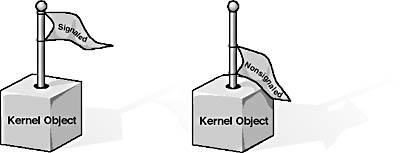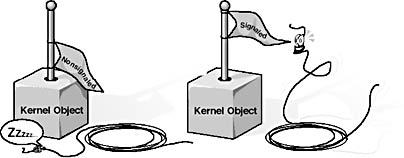Chapter 9 -- Thread Synchronization with Kernel Objects
Chapter 9
In the last chapter, we discussed how to synchronize threads using mechanisms that allow your threads to remain in user mode. The wonderful thing about user-mode synchronization is that it is very fast. If you are concerned about your thread's performance, you should first determine whether a user-mode thread synchronization mechanism will work for you.
While user-mode thread synchronization mechanisms offer great performance, they do have limitations, and for many applications they simply do not work. For example, the interlocked family of functions operates only on single values and never places a thread into a wait state. You can use critical sections to place a thread in a wait state, but you can use them only to synchronize threads contained within a single process. Also, you can easily get into deadlock situations with critical sections because you cannot specify a timeout value while waiting to enter the critical section.
In this chapter, we'll discuss how to use kernel objects to synchronize threads. As you'll see, kernel objects are far more versatile than the user-mode mechanisms. In fact, the only bad side to kernel objects is their performance. When you call any of the new functions mentioned in this chapter, the calling thread must transition from user mode to kernel mode. This transition is costly: it takes about 1000 CPU cycles on the x86 platform for a round-trip—and this, of course, does not include the execution of the kernel-mode code that actually implements the function your thread is calling.
Throughout this book, we've discussed several kernel objects, including processes, threads, and jobs. You can use almost all of these kernel objects for synchronization purposes. For thread synchronization, each of these kernel objects is said to be in a signaled or nonsignaled state. The toggling of this state is determined by rules that Microsoft has created for each object. For example, process kernel objects are always created in the nonsignaled state. When the process terminates, the operating system automatically makes the process kernel object signaled. Once a process kernel object is signaled, it remains that way forever; its state never changes back to nonsignaled.
A process kernel object is nonsignaled while the process is running, and it becomes signaled when the process terminates. Inside a process kernel object is a Boolean value that is initialized to FALSE (nonsignaled) when the object is created. When the process terminates, the operating system automatically changes the corresponding object's Boolean value to TRUE, indicating that the object is signaled.
If you want to write code that checks whether a process is still running, all you do is call a function that asks the operating system to check the process object's Boolean value. That's easy enough. You might also want to tell the system to put your thread in a wait state and wake it up automatically when the Boolean changes from FALSE to TRUE. This way, you can write code in which a thread in a parent process that needs to wait for the child process to terminate can simply put itself to sleep until the kernel object identifying the child process becomes signaled. As you'll see, Microsoft Windows offers functions that accomplish all this easily.
I've just described the rules that Microsoft has defined for a process kernel object. As it turns out, thread kernel objects follow the same rules. That is, thread kernel objects are always created in the nonsignaled state. When the thread terminates, the operating system automatically changes the thread object's state to signaled. Therefore, you can use the same technique in your application to determine whether a thread is no longer executing. Just like process kernel objects, thread kernel objects never return to the nonsignaled state.
The following kernel objects can be in a signaled or nonsignaled state:
Threads can put themselves into a wait state until an object becomes signaled. Note that the rules that govern the signaled/nonsignaled state of each object depend on the type of object. I've already mentioned the rules for process and thread objects. I discuss the rules for jobs in Chapter 5.
In this chapter, we'll look at the functions that allow a thread to wait for a specific kernel object to become signaled. Then we'll look at the kernel objects that Windows offers specifically to help you synchronize threads: events, waitable timers, semaphores, and mutexes.
When I was first learning this stuff, it helped if I imagined that kernel objects contained a flag (the wave-in-the-air kind, not the bit kind). When the object was signaled, the flag was raised; when the object was nonsignaled, the flag was lowered.

Threads are not schedulable when the objects they are waiting for are nonsignaled (the flag is lowered). However, as soon as the object becomes signaled (the flag goes up), the thread sees the flag, becomes schedulable, and shortly resumes execution.

EAN: 2147483647
Pages: 193